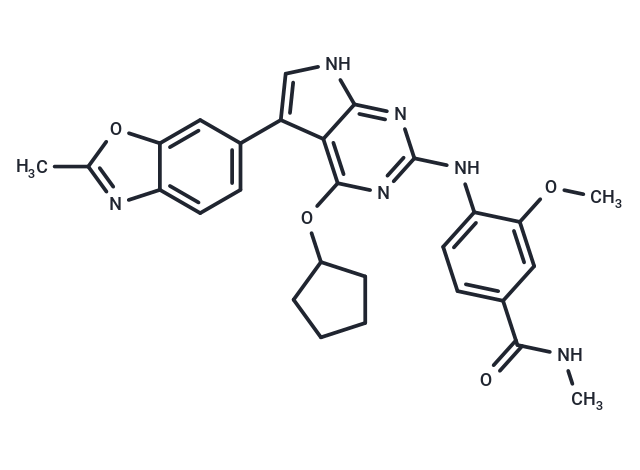Shopping Cart
- Remove All
 Your shopping cart is currently empty
Your shopping cart is currently empty

CC-671 is a dual inhibitor of TTK protein kinase (IC50: 0.005 μM) and CLK2 (IC50: 0.006 μM).

| Pack Size | Price | Availability | Quantity |
|---|---|---|---|
| 1 mg | $48 | In Stock | |
| 5 mg | $113 | In Stock | |
| 10 mg | $189 | In Stock | |
| 25 mg | $378 | In Stock | |
| 50 mg | $568 | In Stock | |
| 100 mg | $815 | In Stock | |
| 500 mg | $1,680 | In Stock | |
| 1 mL x 10 mM (in DMSO) | $129 | In Stock |
| Description | CC-671 is a dual inhibitor of TTK protein kinase (IC50: 0.005 μM) and CLK2 (IC50: 0.006 μM). |
| Targets&IC50 | CLK2:0.006 μM, TTK:0.005 μM |
| In vitro | HCT-116 cell lysates treated with CC-671 at 3 μM for 1 h demonstrates that only four kinases show cellular binding of 75% or more including CLK2, CAMKK2, PIP4K22, and JNK[1]. |
| In vivo | CC-671 significantly inhibits tumor growth by 71% at doses of both 10 and 20 mg/kg on an every 3 days (q3d) dosing schedule, with no difference in efficacy between the two doses. However, it induces greater body weight loss at 20 mg/kg compared to 10 mg/kg (17% vs 5%)[1]. |
| Kinase Assay | The kinase selectivity profile of CC-671 is assessed. The screen is conducted with the concentration of CC-671 held constant at 3 μM. The TTK binding affinity is measured using the kinase binding assays. The kinase binding assays are based on the binding and displacement of a proprietary, Alexa Fluor 647-labeled, ATP-competitive kinase inhibitor scaffold[1]. |
| Animal Research | Female SCID mice are inoculated subcutaneously with 5×106 Cal-51 cells. Mice with tumours of approximately 125 mm3 are randomized and treated intravenously at various doses and schedules of CC-671 (n=8 to10/group). Tumours are measured twice a week for the duration of the study. The long and short axes of each a tumour are measured using a digital calliper in millimetres and the tumour volumes are calculated[1]. |
| Molecular Weight | 512.56 |
| Formula | C28H28N6O4 |
| Cas No. | 1618658-88-0 |
| Smiles | CNC(=O)c1ccc(Nc2nc(OC3CCCC3)c3c(c[nH]c3n2)-c2ccc3nc(C)oc3c2)c(OC)c1 |
| Relative Density. | 1.351 g/cm3 (Predicted) |
| Storage | Powder: -20°C for 3 years | In solvent: -80°C for 1 year | Shipping with blue ice. | ||||||||||||||||||||||||||||||
| Solubility Information | DMSO: 50 mg/mL (97.55 mM), Sonication is recommended. | ||||||||||||||||||||||||||||||
Solution Preparation Table | |||||||||||||||||||||||||||||||
DMSO
| |||||||||||||||||||||||||||||||

Copyright © 2015-2025 TargetMol Chemicals Inc. All Rights Reserved.